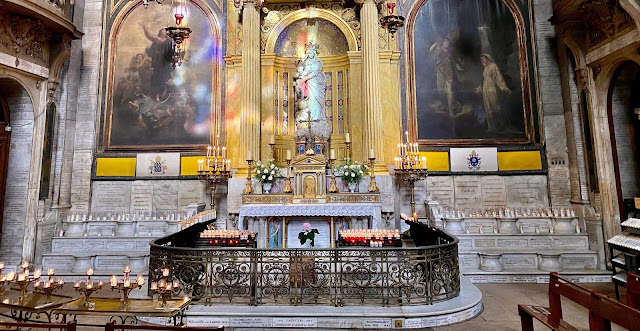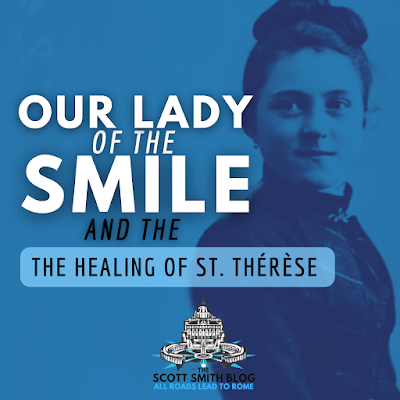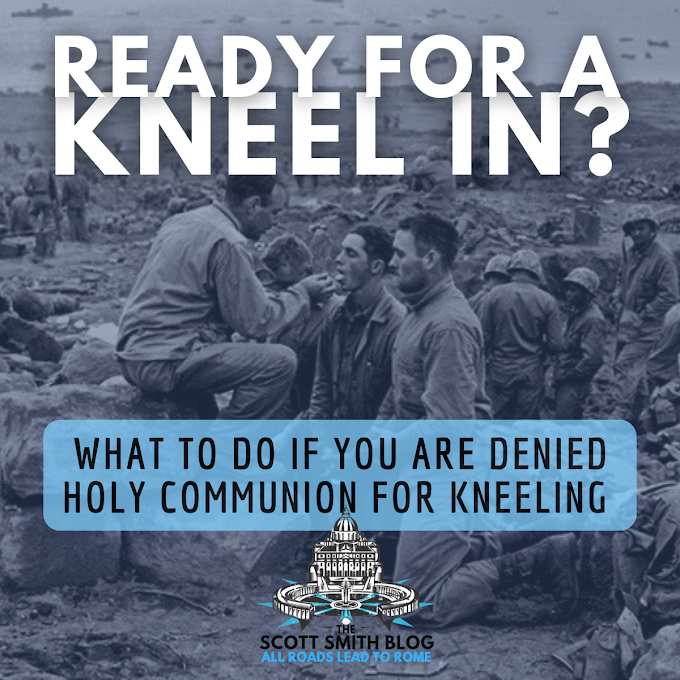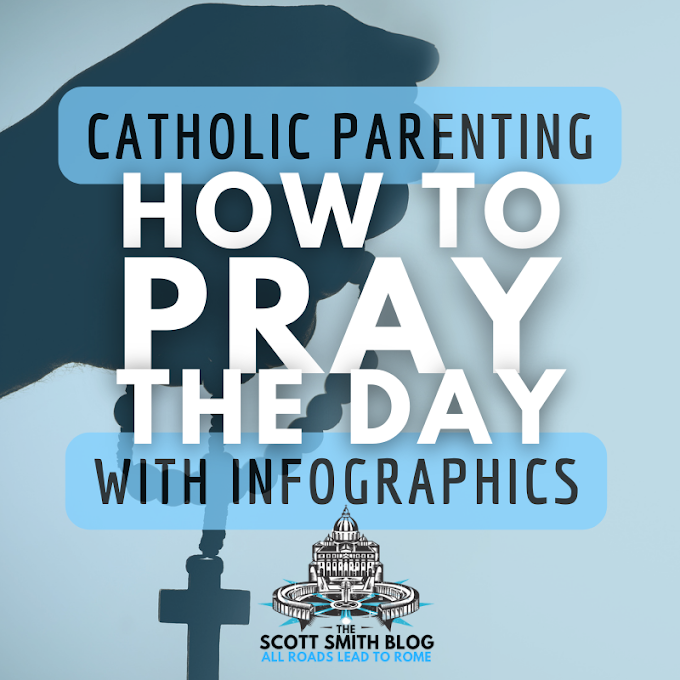Did you know the Blessed Mother appeared to St. Thérèse of Lisieux?
And did you know, when St. Thérèse was a girl, she suffered nearly nine months of demonic torments? And that her healing or freeing from these attacks coincided with this apparition of the Blessed Mother?
This was the apparition of Our Lady of the Smile.
The Martin's family statue of the Blessed Mother smiled at St. Thérèse.
And, did you know this statue and the Miraculous Medal were based on the same statue that was destroyed in the French Revolution?
And did you know this also connects to the feast of Our Lady of Victory?
And did you know this appearance of the Blessed Mother to the child Thérèse also foreshadowed Mary's appearance to the shepherd children of Fatima?
You've got to read about this!
Catholic Near-Death Experiences
By the way, this is just a small section of a book I am writing on Catholic Near-Death Experiences that will be published this year by Sophia Institute Press
Stay tuned for more on that ...
Read St. Thérèse's Autobiography, Story of a Soul
Much of the following is excerpts from St. Thérèse's Autobiography, Story of a Soul. I have published an edition of this book with photographs taken by St. Thérèse's sister, as well as study guide questions. Follow the links below to buy a copy:
The Month of October, Where Coincide the Feasts of St. Thérèse, Our Lady of Victory, and Our Lady of the Smile
October is an auspicious month for St. Thérèse of
Lisieux, and an important month for the Blessed Mother, as well.
We celebrate October 1 as the feast of St. Thérèse—this
is very near the date of her death September 30, 1897. October 2 was also a
significant day to St. Thérèse. It was on this day in 1882 that her second
mother, her sister Pauline, entered the Carmelite monastery. It was on this
same day—perhaps because the devil could not abide the thought of two Martin
sisters entering the monastery and all the future defeats this would mean—that
10-year-old Thérèse fell deathly and mysteriously ill.
St. Thérèse describes her illness as the devil’s retribution
in her autobiography, Story of a Soul.[1]
This
suffering so affected me that I soon became seriously ill. The illness was
undoubtedly the work of the devil, who, in his fury at this first entry into
the Carmel, tried to avenge himself on me for the great harm my family was to
do him in the future.
October 7 is
the feast of Our Lady of the Rosary, which was originally named Our Lady of
Victory. This feast commemorates the Battle of Lepanto of 1571. The whole of
Christian Europe joined in praying the Rosary to protect the combined Christian
navies of the Holy League, which were significantly outnumbered by the Muslim
fleet. It was a decisive victory for the Church, and Pope Pius V instituted the
feast of Our Lady of Victory. This marked the high-water mark of Muslim power
and expansion in the Mediterranean.
These are all very big, complex, and world-sized
events. Far too big for the Little Flower, it seems. So St. Thérèse planted a
little flower beside the great oaks of these world events, a special,
additional, though little-known feast for the Blessed Mother on October 7.
This is the story of how the Blessed Mother
received the title of Our Lady of the Smile. As St. Thérèse wrote in Story
of a Soul, “A miracle was necessary, and it was Our Lady of Victories who
worked it.”
The Nature of the Sickness
On October 2, 1882, St. Thérèse’s dearest sister Pauline
entered the Carmelite monastery. After the death of their mother (now St.)
Marie-Azelie, Pauline had been Thérèse’s second mother. Thérèse was only 4
years old when her mother died, and now it seemed, she was losing her mother
all over again.
 |
| Saints Marie-Azelie and Louis Martin |
Thérèse did not yet know the “joy of sacrifice” and suffering, so her pain at this parting was intense. She wrote:[2]
How
can I describe the anguish I suffered! In a flash I saw life spread out before
me as it really is, full of sufferings and frequent partings, and I shed bitter
tears.
Pauline’s entrance into the monastery seemed to
bring on incurable physical and mental torments for young Thérèse. Thérèse
began to suffer terribly, but it was not for just one or two weeks. It was
months.
The sickness began with comnstant headaches. These
intensified as winter approached, leading to shivering, convulsions,
hallucinations, pains, and lack of appetite.
St. Thérèse’s doctors, including psychiatrist Dr.
Marie-Dominique Fouqueray, were baffled by the young girl’s disease.[3]
Thérèse’s sister Marie, who never left her side through her torments, recalled hearing
the doctor’s prognosis after observing one of the girl’s strange fits. The
doctor said there was nothing science could do for the child. No treatment
helped.
There was no respite from her torments, except for
one day, April 6, 1883. It was the day Pauline received her habit at Carmel. It
was also Eastertide.[4]
The Little Flower had been suffering for nearly seven months at this
point.
St. Thérèse describes this day in her autobiography
and makes it clear that there was no merely natural origin to her illness:
On
reaching home I was made to lie down, though I did not feel at all tired; but
next day I had a serious relapse, and became so ill that, humanly speaking,
there was no hope of any recovery.
I do
not know how to describe this extraordinary illness. I said things which I had
never thought of; I acted as though I were forced to act in spite of myself; I
seemed nearly always to be delirious; and yet I feel certain that I was never,
for a minute, deprived of my reason.
Sometimes
I remained in a state of extreme exhaustion for hours together, unable to make
the least movement, and yet, in spite of this extraordinary torpor, hearing the
least whisper. I remember it still. And what fears the devil inspired! I was
afraid of everything; my bed seemed to be surrounded by frightful precipices;
nails in the wall took the terrifying appearance of long fingers, shriveled and
blackened with fire, making me cry out in terror. One day, while Papa stood
looking at me in silence, the hat in his hand was suddenly transformed into
some horrible shape, and I was so frightened that he went away sobbing.
But if
God allowed the devil to approach me in this open way, Angels too were sent to
console and strengthen me. Marie never left me, and never showed the least
trace of weariness in spite of all the trouble I gave her.
The nature of St. Thérèse’s sickness appeared to be
supernatural in origin. Though she was been harassed by the devil, she was not
possessed. Another one of Thérèse’s sisters, Céline Martin, who later became Sister
Geneviève of Saint Teresa, provided testimony evidencing this point. Witnessing
her sister’s sufferings, Céline noted, “However, unlike with illnesses caused
by the devil, pious objects never frightened her.” Demonstrating revulsion to
holy or blessed objects is a tell-tale symptom of demonic possession.
That St. Thérèse was suffering from demonic harassment,
however, appears clear. St. Thérèse’s cries of distress were terrifying to all those
around her.
St. Thérèse’s sister Marie never left her side.
Like Pauline, Céline, and Thérèse, Marie also later became a religious, taking
the name Sister Marie of the Sacred Heart.
Sister Marie was asked to provide testimony for
the beatification and subsequent canonization of St. Thérèse. Regarding this
period, Sister Marie testified that, although Thérèse never lost her ability to
reason, she experienced “terrifying visions that gave chills to all those who
heard her cries of distress.”
Sister Marie described that during some of the
incidents, “Her eyes, which were usually so calm and gentle, had an expression
of terror in them that is impossible to describe.”
Thérèse’s Father, St. Louis Martin
One such example of these terrifying visions was
the transformation of her father’s hat, described above. Thérèse recalled
watching as her father’s lumpy, worn hat suddenly morphed into some hideous,
menacing shape.
Her father, Louis Martin—now Saint Louis
Martin—was so disturbed that he began to weep in despair. After half a year of
these unending torments, Louis was grief-stricken over the fate of his daughter.
Thérèse recalled how her father suffered greatly,
thinking that she was going to die. Louis had already lost his wife and many of
his children. Thérèse said that the Lord might have comforted her father during
this time, telling him “This sickness is not unto death, but for the glory of
God.”[5]
Of course, if Thérèse indeed had such awareness, she might also have comforted
her father.
Thérèse realized, perhaps later, that her father
did not know that “the Queen of Heaven was watching faithfully over her Little
Flower, that she was smiling upon it from on high, ready to still the tempest
just when the delicate and fragile stalk was in danger of being broken once and
for all.”
In May 1883, Louis came to Thérèse’s room to give money
to Marie, ever at Thérèse’s side, to send for a novena of prayers to be offered
for a cure at the shrine and basilica of
Notre-Dame-des-Victoires in Paris—another connection to Our Lady of Victory.[6]
Given the non-natural origin of Thérèse’s illness, it appeared that a miracle
was necessary to restore her health.
 |
| Basilica of Notre Dame des Victoires, Paris |
“Yes, a great miracle, and this was wrought by Our Lady of Victories herself,” Thérèse would later write.
The Statue of the Blessed Mother
In addition to sending Marie for a novena, Louis brought
a statue of the Blessed Mother into Thérèse’s room. This would prove pivotal.
The particular statue venerated in the Martin’s
home was a copy of a much-loved statue of the Blessed Virgin Mary created in 1735
by Edme Bouchardon[7] and
later destroyed during the French Revolution. It also closely resembled the
image of the Blessed Mother found on the Miraculous Medal, which were first
created in Paris in 1832 and thought to be also inspired by Bouchardon’s 1735
statue of the Blessed Mother.[8]
It is believed that Catherine Labouré’s confessor, Fr. Jean Marie Aladel,
presented the goldsmith Adrien-Jean-Maximilien Vachette with a copy of Bouchardon’s
statue to use as inspiration.[9]
 |
| The Chapel of Our Lady of the Miraculous Medal, Paris: as the original Edme Bouchardon statue was destroyed in the French Revolution, this is another iteration of the original |
Moments of relief were few and far between during Thérèse’s strange and prolonged illness. Nevertheless, in those few precious moments, Therese contented herself by weaving embellishments for the Blessed Mother’s statue.
Thérèse beautifully described her beloved pastime
and the Little Flower’s “shining sun”:[10]
When my sufferings
grew less, my great delight was to weave garlands of daisies and forget-me-nots
for Our Lady’s statue. We were in the beautiful month of May, when all nature
is clothed with the flowers of spring; the Little Flower alone drooped, and
seemed as though it had withered forever. Yet she too had a shining sun, the
miraculous statue of the Queen of Heaven. How often did not the Little Flower
turn towards this glorious Sun!
The Little Flower would not “droop” and “wither
forever,” nor even much longer.
Here is the actual Our Lady of the Smile statue from the Carmel in Lisieux. It is located above the corpus and relics of St. Therese, which are pictured in the foreground of the picture on the left. These were thoughtfully contributed by a friend of mine:
The Novena Concludes & Pentecost Sunday
May 13, 1883 was another auspicious day for Thérèse.
Not only was in Pentecost Sunday, but it was one of the last Sundays of the
Novena of Sundays that her father had sought from Notre-Dame-des-Victoires. It
was also another date of Marian significance, for on this date in 34 years, Our
Lady would appear to the children of Fatima.
Marie, who rarely left Thérèse’s side had,
surprisingly, left Thérèse’s side. Marie was in the garden while Léonie, yet another
of Thérèse’s sisters, remained at her side.
Thérèse would later describe what happened next:
I began to call:
“Marie! Marie!” very softly … so I called louder, until Marie came back to me.
I saw her come into the room quite well, but, for the first time, I failed to
recognize her. I looked all round and glanced anxiously into the garden, still
calling: “Marie! Marie!”
When Thérèse still did not recognize her after
several efforts, Marie knelt down in tears at the foot of Thérèse’s bed. Marie turned
towards the statue of the Virgin Mary and begged her intercession with all the fervor
of a mother who begs for the life of her child and will not be refused.
Thérèse’s sister Léonie, later Sister
Françoise-Thérèse Martin, testified how, at that moment, all three of Thérèse’s
sisters fell to their knees filled with hope as they implored Our Lady to heal
their little sister. It is a scene reminiscent of another group of four sisters,
the March sisters of the novel Little Women, begging for the health of
their sister, Beth.
Marie, as Sister Marie of the Sacred Heart,
testified that she thought this was finally going to be the dreaded, final moment
of Thérèse’s torments. Her death. She and her sisters threw themselves “at the
foot of the statue of the Blessed Virgin,” Marie said.
Thérèse later wrote how the pleas of her sisters
were a storm sent up to Heaven:
That cry of faith forced the gates of
Heaven. I too, finding no help on earth and nearly dead with pain, turned to my
Heavenly Mother, begging her from the bottom of my heart to have pity on me.
The result of these prayers was both swift and startling, at
least for Thérèse. She wrote next how the statue of Our Lady responded:
Suddenly the statue seemed to come to
life and grow beautiful, with a divine beauty that I shall never find words to
describe. The expression of Our Lady’s face was ineffably sweet, tender, and compassionate;
but what touched me to the very depths of my soul was her gracious smile. Then,
all my pain vanished, two big tears started to my eyes and fell silently … They
were indeed tears of unmixed heavenly joy. “Our Blessed Lady has come to me,
she has smiled at me. How happy I am, but I shall tell no one, or my happiness
will leave me!” Such were my thoughts.
Thus came to be Our Lady of the Smile.
St. Thérèse is Cured
“Our Blessed Lady has come to me; she has smiled
at me,” Thérèse recounted.
It is important to remember at this point that this
was not the first time in her life that Thérèse had been brought back from the
brink of death by a miraculous cure. As is his way, St. Joseph protected the
baby Thérèse from death and the devil, preserving her to be raised in the holy
warmth of Mother Mary.
Céline later recounted this divine intervention
early in Thérèse’s life. Thérèse was dying of a fatal intestinal disorder that
had already claimed the deaths of two Martin children, but Thérèse’s mother, now-Saint
Marie-Azélie Guérin Martin, fell to her knees before another family statue,
that of St. Joseph. Azélie’s pleas before St. Joseph’s statue must have
mirrored the pleas of the Little Flower’s three sisters before Our Lady’s
statue.
Heaven responded, as it so often would when the
Martin family combined their pleas, and Thérèse survived.
And now, perhaps remembering the work of her most
chaste spouse, the Virgin Mary personally appeared to cure the Little Flower.
As if the Virgin Mary’s apparition was not enough in
itself, Thérèse further elaborated on the lasting effects of Marie’s prayers:
[Marie’s] prayers
had gained me this unspeakable favor: a smile from the Blessed Virgin! When [Marie]
saw me with my eyes fixed on the statue, she said to herself: “Thérèse is
cured!” And it was true. The Little Flower had come to life again—a bright ray
from its glorious Sun had warmed and set it free forever from its cruel enemy. “The
dark winter is past, the rain is over and gone,”[11] and
Our Lady’s Little Flower gathered such strength that five years later it opened
wide its petals on the fertile mountain of Carmel.
Not only had the warmth of the Virgin Mary’s smile cured
Thérèse, such warmth would carry Thérèse all the way to her entrance into the Carmelite
monastery. But her entrance to Carmel would be its own ordeal, requiring additional
intercession and suffering, as Thérèse resolved to enter the Carmelites at the uncustomary
age of fifteen.
A Blessing and a Curse
St. Thérèse had resolved to tell no one of her miraculous
experience, writing “How happy I am, but I shall tell no one, or my happiness
will leave me!”
Thérèse’s vision had lasted for over forty minutes.
It may have felt like just a moment to Thérèse, but she had been transfixed on
the statue for a substantial amount of time. Her sisters noticed.
After the apparition, Thérèse looked around at her
sisters, and “recognized Marie; she seemed very much overcome, and looked
lovingly at me, as though she guessed that I had just received a great grace.”
Marie soon asked Thérèse to reveal what had
happened. She fully believed the Blessed Mother had appeared to Thérèse. The Little
Flower admitted that she “could not resist her tender and pressing inquiries.”
Thérèse waited until she was alone with Marie. She
told Marie that she was astonished that Marie knew her secret, even though she
had not said a word. Thérèse then divulged what had happened and how the
Blessed Mother had smiled at her. After she told Marie the details, though, her
joy soured: “Alas! as I had foreseen, my joy was turned into bitterness. For
four years the remembrance of this grace was a cause of real pain to me.”
Marie was bursting with excitement over the
Blessed Mother’s miracle and apparition. This is, of course, a very understandable
sentiment. And yet, the devil seemed to turn it to his advantage.
Marie begged Thérèse for permission to share her secret
with the nuns at the Carmelite monastery. Thérèse found she could not refuse
her sister. When Thérèse first visited Pauline again after her dramatic
recovery, she was initially overflowing with joy at seeing her sister clothed
in the habit of Our Lady of Carmel. “My heart,” she said, “was so full that I
could hardly speak.”
Then, things soured as Thérèse was questioned by the
other Carmelite nuns:
Some
asked if Our Lady was holding the Infant Jesus in her arms, others if the
Angels were with her, and so on. All these questions distressed and grieved me,
and I could only make one answer: “Our Lady looked very beautiful; I saw her
come towards me and smile.” But noticing that the nuns thought something quite
different had happened from what I had told them, I began to persuade myself
that I had been guilty of an untruth.
Though Thérèse lamented the loss of the happiness that the appearance
of Our Lady of the Smile had given her, she mused also on the purpose of such
loss:
Our Lady allowed this trouble to befall me for the good of my soul;
perhaps without it vanity would have crept into my heart, whereas now I was
humbled, and I looked on myself with feelings of contempt. My God, Thou alone
knowest all that I suffered!
This period of humility, while formative, would not continue
unabated forever. It would be four years:
For
four years, the remembrance of this grace was a cause of real pain to me, and
it was only in the blessed sanctuary of Our Lady of Victories, at my Mother’s
feet, that I once again found peace. There it was restored to me in all its
fullness, as I will tell you later.
At the Basilica of Our Lady of Victories
It was the early morning 4th November 1887,
and the Little Flower and her family were passing alone through the silent streets
of Lisieux to the train station.[12]
They were leaving on a pilgrimage to Paris and Rome.
Each of the train compartments bore the name of a
saint. The Martin family’s compartment bore the name “St. Martin,” and
everybody on the pilgrimage took to calling the future St. Louis Martin by “St.
Martin.”
In Paris, Louis took his family to see all the
sights in Paris, but for Thérèse one sight overshadowed all the others: the basilica
of Notre-Dame-des-Victoires. It was at this same shrine of Our Lady of
Victories that the novena had been prayed for Thérèse’s cure at her father’s request.
And it was also at the basilica that Thérèse would
be healed a second time. All the doubts that had come to torment Thérèse following
the Blessed Mother’s apparition vanished and she once again found peace.
I
can never tell you what I felt at her shrine; the graces Our Lady granted me
were like those of my First Communion Day. I was filled with peace and
happiness. In this holy spot the Blessed Virgin, my Mother, told me plainly
that it was really she who had smiled on me and cured me. With intense fervor,
I entreated her to keep me always, and to realize my heart’s desire by hiding
me under her spotless mantle, and I also asked her to remove from me every
occasion of sin.
Thérèse’s sister Marie also testified regarding
this event: “It was at the foot of Our Lady of Victories in Paris that her
inner struggles ceased … she received confirmation … of the truth of the
vision.”
The timing of this second encounter with the
Blessed Mother was no coincidence. It prepared the Little Flower for her
meeting with Pope Leo XIII when the pilgrimage reached Rome.
Audaciously, and despite being told to say nothing
before the pope, the Little Flower made a bold request of the Holy Father:
I
kissed his foot and he held out his hand; then raising my eyes, which were
filled with tears, I said entreatingly: “Holy Father, I have a great favour to
ask you.” At once he bent towards me till his face almost touched mine, and his
piercing black eyes seemed to read my very soul. “Holy Father,” I repeated, “in
honor of your jubilee, will you allow me to enter the Carmel when I am
fifteen?”
Thérèse had made a special request to enter the
Carmelites early at fifteen years old. This request had slowly ascended the
ranks to the desk of the Bishop of Bayeaux, but there it had stalled. Emboldened
now by the Blessed Mother, Thérèse decided to make her appeal directly to the
pope.
What was the pope’s response?
After some explanation from the Vicar-General of
Bayeaux and a second plea from Thérèse, the pope responded, “Well, well! You
will enter if it is God’s Will.”
Thérèse was ushered away before she could make a
third plea, but within a month, on December 28, the Feast of the Holy
Innocents, the Bishop of Bayeux granted Thérèse’s special request and authorized
her “immediate entry into the Carmel.”[13]
The rest, as they say, is history.
Prayer to Our Lady of the Smile
Do you feel a stirring of devotion to Our Lady of the Smile? Here is the prayer for her intercession:[14]
Prayer to Our Lady of the Smile
O Mary, Mother of Jesus,
and our gentle Mother too,
with a visible and radiant smile
you consoled and cured
your beloved child, St. Thérèse of the Child
Jesus.
We ask you now to smile on us,
amid the troubles of our lives.
May your gentle smile bring light and healing
to the darkness and disease of our body, mind and
spirit.
Instill us with hope and deepen our faith
so that we enjoy forever
your maternal and enrapturing smile in heaven.
Amen.
Footnotes: Our Lady of the Smile & St. Thérèse of Lisieux
[1] Story
of a Soul, Chapter 3: “Pauline Enters Carmel”
[2] Story
of a Soul, Chapter 3: “Pauline Enters Carmel”
[3] Dr.
Marie-Dominique Fouqueray, “A Strange Illness: The Illness of Thérèse at Age
Ten from Easter to Pentecost 1883.”
[4]
Easter Sunday was on March 25 in 1883, which happened to coincide that year
with the Solemnity of the Anunciation.
[5] John
11:4
[6]
The Basilica of Notre-Dame-des-Victoires was named by King Louis XIII, who
dedicated it to his victory over the Protestants at La Rochelle in 1628 during
the French Wars of Religion. It was not named for Our Lady of Victory.
Nevertheless, it is the same Blessed Mother interceding for both victories.
[7] 1698-1762
[8]
The Blessed Mother appeared to St. Catherine Labouré in 1830, but the first
medals were not fashioned until 1832.
[9] Descouvemont/Loose.
[10] Story
of a Soul, Chapter 3: “Pauline Enters Carmel”
[11] Song
of Solomon 2:11
[12] Story
of a Soul, Chapter 6: “A Pilgrimage to Rome”
[13] Though
the Bishop’s permission reached the Carmelite monastery in December that Thérèse
be allowed to enter immediately, the Mother Superior resolved not to allow her
entrance until the customary time during the Easter season. Thérèse describes
this in her autobiography: “You told me, dear Mother, that you had had the
Bishop’s answer since December 28, the feast of Holy Innocents; that he
authorized my immediate entry into the Carmel, but that nevertheless you had
decided not to open its doors till after Lent. I could not restrain my tears at
the thought of such a long delay. This trial affected me in a special manner,
for I felt my earthly ties were severed, and yet the Ark in its turn refused to
admit the poor little dove.”
[14]
“The Healing of Our Lady of the Smile,” Society of the Little Flower, January
9, 2021, accessed via littleflower.org.



%20Allegoria%20della%20battaglia%20di%20Lepanto%20-%20Gallerie%20Accademia.jpg)












0 Comments